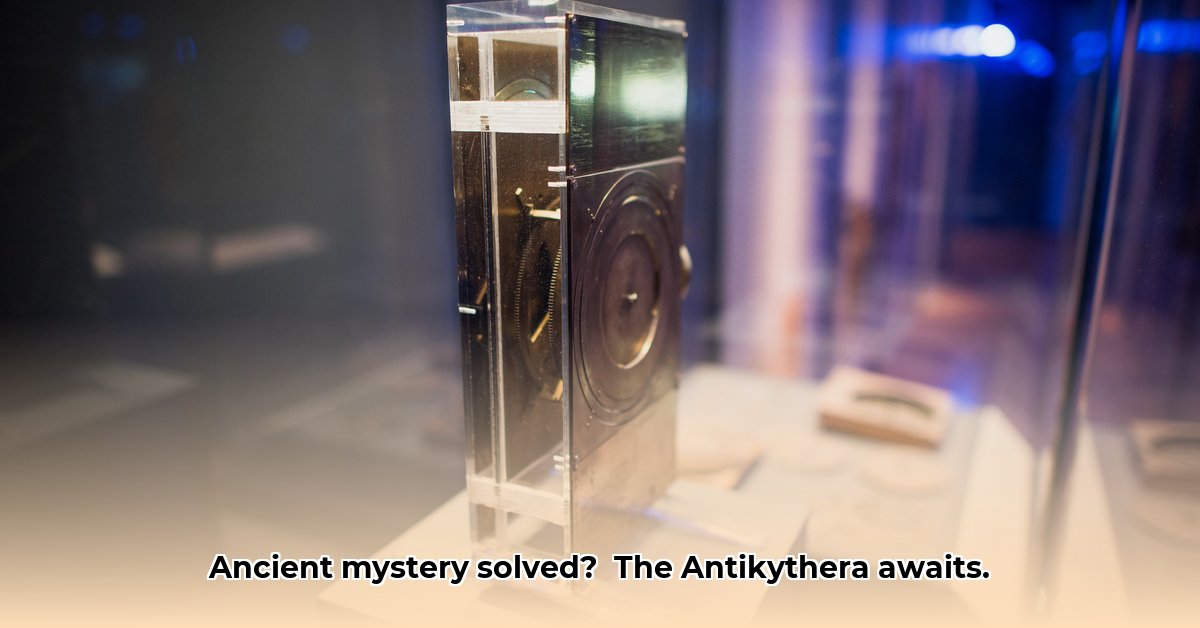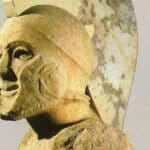Picture this: Divers pull a rusty, ancient lump of metal from a shipwreck. It’s broken, covered in sea slime, but inside hides something incredible – a device so advanced, it shouldn’t exist. That’s the Antikythera Mechanism. This mind-boggling piece of ancient Greek technology has puzzled scientists for over a century. It’s a story of accidental discovery and the ongoing quest to understand its function and what it reveals about the builders’ ingenuity. We’ll explore its gears, astronomical calculations, and place in history – demonstrating how this ancient “computer” still amazes us and how we’re only beginning to crack its code. For more on ancient computing, see this digital archive.
The Antikythera Mechanism: Unraveling the Mystery of the World’s First Computer
Imagine scuba divers exploring a sunken ancient Greek ship, the Antikythera wreck, in 1901. Among the pottery and statues, they found something truly baffling: a corroded lump of bronze, resembling a jumbled mess of gears – but so much more. This accidental discovery has captivated scientists and historians, revealing a glimpse into the astonishing ingenuity of ancient Greece and challenging our understanding of technological advancement in fields like mechanical engineering. This is the story of the Antikythera Mechanism, often called the world’s first computer and a major leap in ancient technology.
A Deep-Sea Enigma: The Mechanism’s Discovery
The initial find wasn’t spectacular. The corroded bronze pieces didn’t immediately shout “amazing astronomical calculator!” They looked more like scrap metal from a shipwreck. Only after careful cleaning and examination did researchers recognize the intricate mechanisms hidden within the green-tinged crust of sea minerals. Each gear, each tiny component, revealed an increasingly complex story of ancient engineering prowess. The more they uncovered, the more astonishing the device became, transforming a simple finding into an artifact of immense historical and scientific significance. The divers were from the island of Symi and were initially searching for sponges when they came across the wreck.
Ancient Greek Genius: More Than Just Gears
The Antikythera Mechanism isn’t just a collection of gears; it’s a breathtaking display of mechanics and astronomy. This sophisticated device, meticulously crafted from bronze, is packed with gears, dials, and pointers. It testifies to the advanced knowledge of the ancient Greeks, far beyond what many historians once believed possible for that time period — pushing back the timeline of complex technology by centuries. This amazing invention challenged conventional historical timelines. Contemporary sources, such as writings by Cicero, mention similar devices, suggesting that the Antikythera Mechanism may not have been a unique invention but part of a broader tradition of complex mechanical devices in the ancient world.
Decoding the Cosmos: Functions and Capabilities of this Ancient Marvel
Thanks to modern technology like X-rays and advanced imaging, we’ve peered into the heart of this ancient wonder. Scientists have determined that it was a remarkably accurate predictor of celestial movements. Imagine having a handheld device thousands of years ago that precisely tracked the movements of the sun, moon, and planets! It could even predict eclipses, a crucial capability for ancient societies. That’s not all – it was also a sophisticated calendar, keeping track of various cycles, including the dates of the ancient Olympic Games and other athletic festivals. Essentially, it was a portable planetarium and astronomical calendar, all in one. Pretty impressive for something found in a shipwreck! This ability to predict eclipses likely held significant cultural and religious importance, as eclipses were often seen as omens.
The Inner Workings: Gears, Calendars, and Cosmic Calculations
The magic lies in the mechanism’s use of differential gears – a system for precisely calculating planetary movements that wasn’t reinvented until centuries later. These tiny, precisely cut gears worked together in harmony, a miniature marvel of engineering, to display celestial positions and predict astronomical events. It wasn’t just about predicting where the planets would be; it also tracked time itself with remarkable accuracy. The inclusion of cycles like the Metonic cycle (a 19-year lunar cycle) and the Callippic cycle (a 76-year cycle) shows a very deep understanding of long-term astronomical patterns. This speaks volumes about the mathematical and astronomical knowledge possessed by its creators. Inscriptions on the mechanism, deciphered using advanced imaging techniques, provide further insight into its functions and the astronomical theories behind its design.
Unlocking the Secrets: Ongoing Research
Despite the incredible progress made in understanding the Antikythera Mechanism, many questions remain. Some experts are still debating the exact purpose of certain dials and pointers, which presents challenges in understanding the mechanism’s complete functionality. Others are trying to reconstruct missing pieces to fully understand the device’s capabilities. What other calculations could it perform beyond those already discovered? Were there functions we haven’t yet deciphered? The inscriptions on the device, only partially understood, continue to offer clues to its operation and usage, revealing an ancient user manual. It seems the mechanism may have been far more sophisticated than we initially realized, and that we’re still just scratching the surface. The complexity invites continued exploration and interpretation. Ongoing research involves international collaborations, bringing together experts from various fields to pool their knowledge and resources.
A Legacy of Innovation: Insights into Ancient Civilization’s Science and Technology
The Antikythera Mechanism is more than just an object; it’s a powerful symbol of human ingenuity. It challenges our assumptions about ancient civilizations, revealing a level of scientific and engineering expertise that’s truly awe-inspiring. It demonstrates that advanced technology wasn’t solely a product of the modern era. Its discovery compels us to reassess our understanding of history and the intellectual capabilities of societies long past. The mechanism is a constantly evolving story, reminding us that discovery is a process, not an event. Ongoing research continually reveals new layers of complexity and refines our understanding of this remarkable piece of ancient technology. The device also provides insights into the social and cultural context of ancient Greece, highlighting the importance of astronomy and mathematics in their society.
Key Discoveries and Ongoing Research: A Summary
| Aspect | Current Understanding | Ongoing Research |
|---|---|---|
| Primary Function | Astronomical prediction, calendar calculations, prediction of eclipses and athletic games. | Exploring the full extent of its capabilities and functions, including potential uses in navigation and astrology. |
| Gear System | Sophisticated differential gears, intricate gear trains with over 30 gears. | Precise modeling of the gear ratios and their interactions, investigating the manufacturing techniques used to create such precise components. |
| Inscriptions | Partially deciphered, suggesting operational instructions, astronomical data, and possibly philosophical interpretations of the cosmos. | Complete decipherment and interpretation of the remaining text, using advanced imaging techniques to reveal hidden inscriptions. |
| Construction Date | Estimated between 205 BC and 87 BC. | Refinement of dating techniques to better pinpoint the creation date and identify potential influences from different astronomical traditions. |
| Extent of Planetary Models | Evidence suggests detailed, highly accurate planetary models, incorporating epicycles to account for the irregular movements of celestial bodies. | Reconstruction of missing parts to clarify its full capabilities, exploring the possibility that it could model the entire solar system with even greater accuracy. |
| Origin | Likely originated from Rhodes or a colony of Corinth, supported by month names and festival references in the inscriptions. | Investigating potential connections to known astronomers and engineers of the time, such as Hipparchus and Posidonius, who may have contributed to its design or construction. |
The Antikythera Mechanism remains a fascinating puzzle. Its ongoing study continues to reveal new insights into the scientific and engineering achievements of ancient Greece and fundamentally changes our understanding of the capabilities of ancient civilizations. It’s a testament to the enduring power of human curiosity and the mysteries that still lie waiting to be uncovered. The study of the Antikythera Mechanism has implications for our understanding of the history of science and technology, as well as the relationship between science, religion, and culture in the ancient world.
How did ancient Greeks build the Antikythera mechanism’s complex gear system?
Key Takeaways:
- The Antikythera Mechanism, discovered in a shipwreck, is a remarkably sophisticated astronomical calculator from ancient Greece.
- Its intricate gear system allowed it to predict celestial events with surprising accuracy (with error margins of just a few degrees).
- The mechanism’s construction showcases advanced metalworking techniques and a deep understanding of astronomy.
- Researchers continue to unravel its mysteries, using modern technology to analyze its fragmented remains.
- The technology involved in building the Antikythera mechanism pushed the boundaries of what we knew was possible in ancient Greece.
The Antikythera Mechanism: A Puzzle in Bronze
Imagine a device, roughly the size of a shoebox, capable of predicting eclipses, tracking the movements of the sun, moon, and planets, and even displaying the cycles of the ancient Olympic Games. That’s the Antikythera Mechanism—a marvel of ancient Greek engineering discovered in a shipwreck off the coast of Antikythera in 1901. This ancient “computer,” dating back to around 100 BCE, continues to astound scientists and historians alike.
But how did ancient Greeks build the Antikythera mechanism’s complex gear system? That’s the question that has bedeviled researchers for over a century. The mechanism’s intricate network of over 30 gears, many smaller than a coin, is unparalleled in its complexity for its time. This highlights the advanced metallurgical and engineering practices in that era. Some gears are as small as 1 cm in diameter, requiring incredible precision in their creation.
The Craftsmanship: Precision in Bronze and Metallurgical Accomplishments
The gears themselves are painstakingly crafted from bronze (an alloy of copper and tin). The precision involved is astonishing. Think of creating perfectly interlocking teeth on such tiny components, using only ancient tools. Experts believe the Greeks used a lost-wax casting technique, followed by meticulous hand finishing. This process would have required an exceptionally high level of skill and patience. The Greeks’ mastery of bronze casting was already well-known, but the Antikythera Mechanism demands a level of refinement far beyond what was previously assumed. Did they possess specialized tools or techniques that have yet to be discovered? Some researchers suggest the use of lathes or other precision cutting tools, although direct evidence is lacking.
The Mechanics: Epicycles and Accurate Predictions of Celestial Movements
The mechanism’s functionality hinges on a sophisticated understanding of epicyclic gearing. This system uses smaller gears rotating around larger ones to model the irregular movements of planets. By combining different gear ratios, the Greeks created a remarkably accurate model of the solar system. This system wasn’t purely hypothetical; the mechanism’s predictions matched astronomical observations quite well, suggesting a deep knowledge of celestial mechanics. The concept of epicycles was developed by ancient Greek astronomers like Hipparchus and Ptolemy to explain the apparent retrograde motion of planets.
The Mystery Remains: Unanswered Questions Surrounding its Construction
Despite decades of research, many questions surrounding the Antikythera Mechanism remain unanswered. How did ancient Greeks build the Antikythera mechanism’s complex gear system? While we have a basic understanding of their metalworking skills, we still don’t fully grasp the complete design or manufacturing process. We have only fragmented pieces of the original device, and many components are missing. This makes it impossible to fully reconstruct the mechanism. Furthermore, the inscriptions on the mechanism, though partially deciphered, are full of riddles waiting to be solved. How can we leverage modern technology to digitally reconstruct the missing pieces? The use of 3D modeling and virtual reality allows researchers to explore different reconstruction scenarios and test their feasibility.
The Significance: A Technological Leap
The Antikythera Mechanism stands as a testament to the advanced technological capabilities of ancient Greece. Its existence dramatically alters our perception of ancient technology, showcasing a level of sophistication far beyond what we previously imagined. It highlights not only their advanced engineering skills but also their deep understanding of astronomy and mathematics. The mechanism stands as a powerful reminder that the ancient world was not as technologically primitive as we may have once assumed. The device also serves as an inspiration for modern engineers and scientists, demonstrating the ingenuity and resourcefulness of ancient inventors.
Antikythera Mechanism: Preserving and Restoring this Ancient Greek Marvel for Future Generations
Key Takeaways:
- The Antikythera Mechanism, a remarkably complex ancient Greek device, is a testament to the advanced technological capabilities of the Hellenistic period (approximately 323 BC to 31 BC).
- Its intricate gear system allowed for the precise prediction of astronomical events, showcasing a deep understanding of astronomy and mechanics.
- Ongoing research, using modern imaging and analysis techniques, continues to reveal the mechanism’s secrets.
- Preserving and restoring this ancient Greek marvel is crucial for understanding the history of technology and the scientific achievements of ancient civilizations.
- International collaboration is essential for the long-term protection and study of the mechanism.
Unearthing a Technological Masterpiece
Imagine diving into the depths of the Aegean Sea, only to uncover something extraordinary—a device so sophisticated, so far ahead of its time, that its very existence challenges our understanding of ancient Greek technology. That’s exactly what happened in 1901 with the discovery of the Antikythera Mechanism within a shipwreck dating back to roughly 200 BC. This wasn’t just some trinket; this was a complex astronomical calculator, a marvel of engineering that could predict celestial events with astonishing accuracy. The shipwreck itself has yielded other valuable artifacts, providing context for the Antikythera Mechanism and its place in ancient Greek society.
A Mechanism’s Inner Workings and The Gear System
The Antikythera Mechanism, essentially an ancient analog computer, used a series of bronze gears to track the movements of the sun, moon, and planets. Its intricate design incorporated features like epicyclic gearing—a testament to a sophisticated understanding of planetary motion—that would not be independently rediscovered for centuries. Inscriptions on the mechanism’s fragments, painstakingly deciphered by experts, provided additional insights into its function and even potentially served as a user’s manual. These inscriptions are written in ancient Greek and provide valuable clues about the mechanism’s purpose and the astronomical knowledge of its creators.
Unraveling the Mysteries: Ongoing Research
Despite decades of research, some mysteries still surround the Antikythera Mechanism. While experts agree on its basic functions, the exact methods used to compute planetary positions, for instance, remain a subject of ongoing debate. Some scholarly discussions around specific calibration dates highlight just how much we still need to learn. New research suggests that the mechanism may have been calibrated to a specific date, possibly related to an important astronomical event or a political event.
The Significance of Preservation
The Antikythera Mechanism isn’t just a historical artifact; it’s a window into the past, offering glimpses into the brilliance of ancient Greek science and engineering. Preserving and restoring this precious artifact is, therefore, not just a matter of historical preservation, but also a crucial undertaking to safeguard our collective scientific heritage. This long-term commitment involves constant vigilance in maintaining the mechanism’s structural integrity, minimizing environmental damage, and ensuring its accessibility for future researchers. Advanced conservation techniques are used to stabilize the fragile fragments and prevent further corrosion.
Collaborative Efforts For the Future
The global scientific community recognizes the immense significance of the Antikythera Mechanism. The importance of preserving this mechanical marvel for future generations demands a collaborative international approach. Museums, research institutions, and individual scholars are working together to ensure the mechanism’s long-term survival and continued study. These collaborative efforts encompass everything from the implementation of state-of-the-art preservation techniques to the development of accessible educational resources designed to share this invaluable piece of history with the world. The Antikythera Mechanism is housed at the National Archaeological Museum in Athens, Greece, where it is carefully protected and studied by experts.
The Antikythera Mechanism’s Calendrical System: A Deep Dive into its Metonic and Olympic Cycles
Key Takeaways:
- The Antikythera Mechanism, a complex ancient Greek device, accurately tracked multiple calendar systems.
- It incorporated the Metonic cycle, a 19-year period aligning lunar and solar calendars.
- The mechanism also predicted the timing of the ancient Olympic Games.
- Its sophisticated design highlights advanced ancient Greek knowledge of astronomy and engineering.
- Ongoing research continues to reveal the device’s astonishing capabilities.
Imagine a device, built over two thousand years ago, capable of predicting astronomical events with remarkable accuracy. This was the Antikythera Mechanism, a marvel of ancient Greek engineering, and its calendrical system is a testament to their advanced understanding of time. The device is believed to have been used for both practical and ceremonial purposes, reflecting the close relationship between science and religion in ancient Greek society.
Unlocking the Secrets of Time
The mechanism’s sophistication lies particularly in its handling of timekeeping. It didn’t just tell the time; it calculated the movements of the celestial bodies. This involved intricate gearing systems to track the sun, moon and planets, accurately predicting eclipses using the Saros cycle and, most impressively, managing the complexities of calendar systems. The Saros cycle, a period of approximately 18 years, 11 days, and 8 hours, is used to predict the recurrence of eclipses of the Sun and Moon.
More Than Just Months and Years
Many ancient cultures struggled to reconcile the lunar and solar years, as the number of lunar months in a solar year isn’t a whole number. Greek astronomers solved this problem using the Metonic cycle, a 19-year period in which the lunar phases align almost perfectly with the solar year. The Antikythera Mechanism cleverly integrated this ingenious invention into its design. The Antikythera Mechanism’s Calendrical System: A Deep Dive into its Metonic and Olympic Cycles is a story of incredibly precise engineering. The Metonic cycle is named after the Greek astronomer Meton of Athens, who lived in the 5th century BC.
The Ongoing Mystery
Think of the precision involved: Imagine creating a device with dozens of tiny gears that needed to mesh perfectly to calculate movements across decades and centuries. This required a level of manufacturing technique that surprised scientists, as it was much more advanced than previously thought. The mechanism is a testament to how advanced ancient Greek engineering really was. Modern replicas of the Antikythera Mechanism are used to demonstrate its functionalities and to study its engineering principles.
The Challenge
While much has been discovered, the Antikythera Mechanism continues to hold secrets. Scientists use modern imaging technologies like X-rays and 3D modeling to understand its workings. New insights emerge with each analysis. Fragments of the mechanism are still being studied. The study of the Antikythera Mechanism has implications for our understanding of the history of science and technology, as well as the relationship between science, religion, and culture in the ancient world.
The device’s design challenges previous assumptions about the scientific capabilities of ancient civilizations. Ongoing research suggests the possibility of even more sophisticated versions having existed, lost to time. The Antikythera Mechanism isn’t just a relic; it’s a window into a past far more technologically advanced than previously imagined. The discovery of the Antikythera Mechanism has inspired new research into ancient technology and has led to a reassessment of the scientific achievements of ancient civilizations.
















